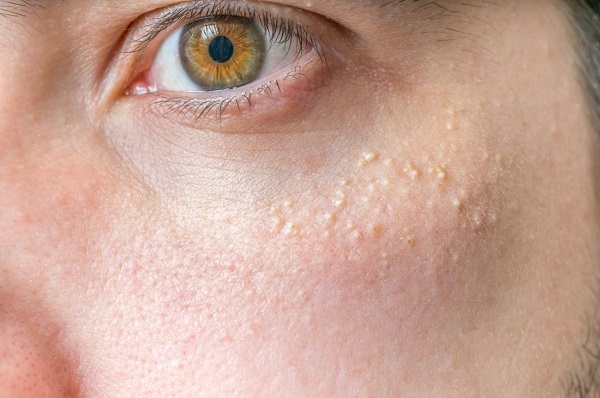Who doesn’t enjoy showcasing their flawless skin, wearing attractive clothes, and looking their best? However, there are occasions when you deal with bothersome patches on your face. Typically, you would merely conceal them with cosmetics in the hopes that they would eventually go away on their own. You would still continually wonder if those spots were noticeable to others, even with makeup. Whether you have eczema, acne, or any other imperfections on your face, you tend to feel insecure when you think about them. It’s difficult to regain that confidence as long as those stains are present.
You’re in luck if you have those strange little white spots on your skin that won’t go away and make you seem older. This essay focuses on those mysteriously bothersome places and offers solutions.
What do those tiny white dots mean?
To rule out whatever you have is your first goal. Milium, or milk spots, are those little white spots that develop on your face if they resemble the picture above. Generally speaking, milia, or tiny groupings of milium cysts, are present. Keratin that is trapped under the skin’s surface is the cause of this.
Where can you find them?
Milia cysts typically develop in or around the mouth, nose, and eyelids. Cysts from milia can disperse all over a baby’s face. They differ greatly from infant acne, albeit (2).
Why Does Milia Occur?
Milia in neonates is typically present at birth, yet its etiology has not yet been identified. However, milia can develop in older kids and adults for a variety of reasons, including burns, UV damage, the use of steroid creams, skin blistering injuries, or even a laser treatment.
How can Mia be treated?
Infants do not need treatment since the cysts often go away after a few weeks.
For older kids and adults, it could take many months for milia to go away naturally. However, there are several treatments that can be quite effective in curing milia. The top 5 solutions you might turn to in your fight against malaria are listed below:
1. Aloe Vera Leaf Gel
This is regarded as the most effective treatment for milia. Apply the gel to the afflicted region using one aloe vera leaf. Consider leaving this on for many hours, ideally overnight, before washing it off. According to reports, doing this twice daily has a speedier effect on milia removal.
2. Steam
Regular steaming of your face greatly reduces the appearance of these obstinate white spots. Use a steamer (available at any drugstore) or a hot shower to transform your bathroom into a steam chamber. As an alternative, you could always go old-school and boil some water in a saucepan on the stove before covering your head with a towel and steaming your face.
Do this every day for 10 to 15 minutes. Your skin gets a break, and your pores might open up as a result. It is quite helpful for eliminating pollutants.
3. Tea Tree Oil
This oil aids in the afflicted area’s disinfection. Tea tree oil also has excellent calming qualities and relieves burning and irritation. Just before going to bed at night, after cleaning your face, dab a few drops of tea tree oil over your face. For the best outcomes, this should also be stored overnight.
4. Peeling off
It’s essential to exfoliate your face once a week to remove any toxins that have been lodged beneath your skin. Although lemon juice and sugar are suggested as the finest natural exfoliants, you may also use an exfoliating face scrub that is readily accessible in stores. Apply some ice cubes to your skin after exfoliating to cool it down and shut your pores to stop toxins from entering your skin again.
5. Dermatologists
There are certain surgical treatments that may be done to remove milia spots right away if you don’t have the time or patience to try home cures. The most popular treatment for milia patches is “cryotherapy.” In order to get rid of those cysts, this method entails exposing your face to a cold gas that causes the afflicted region to freeze.
Other options recommended by doctors include chemical peels, prescription lotions, laser therapy, and even “deroofing,” which involves extracting cysts with a sterile needle. Dermatologists may even nick the skin with a surgical blade before extracting the cysts (4).
There you have it, then! You are now fully aware of the causes of those pesky white milk spots on your face and how to treat them. Let’s make having flawless, beautiful skin a reality rather than just a pipe dream.
